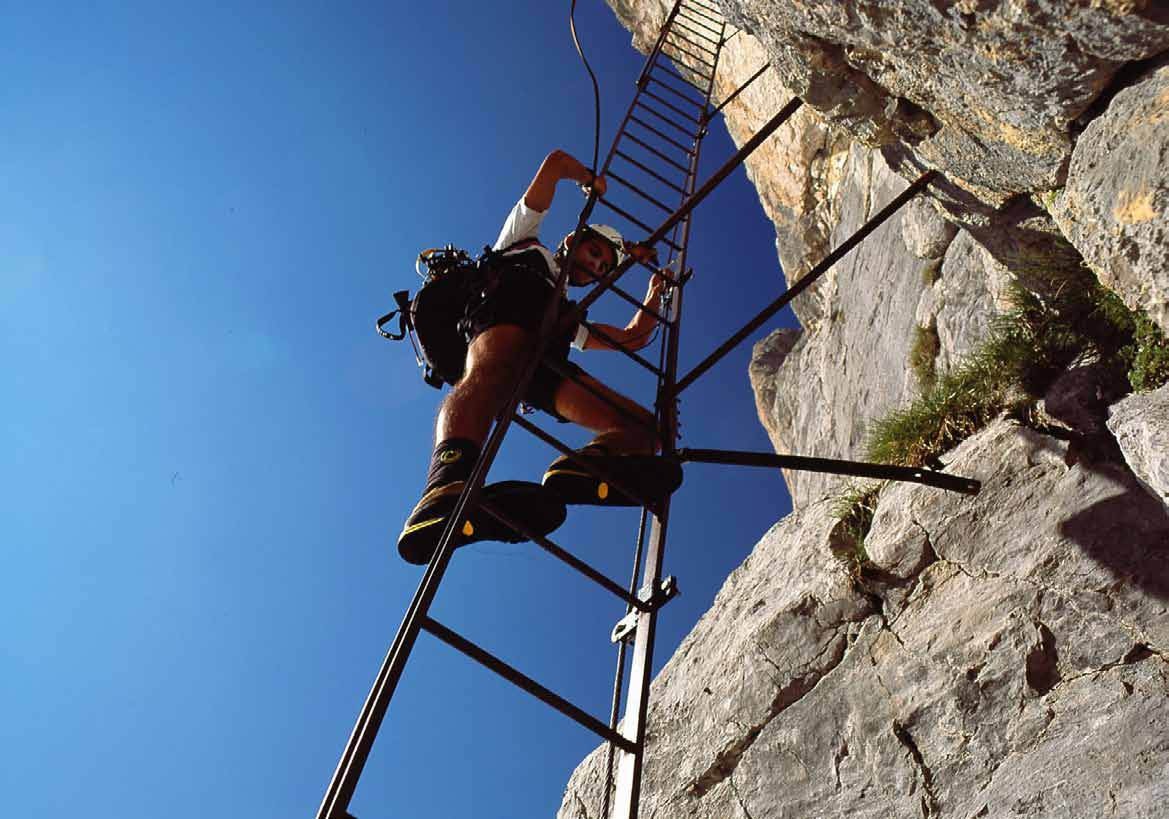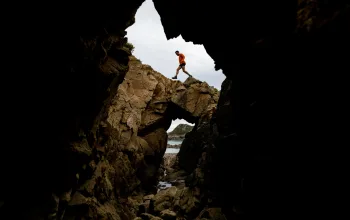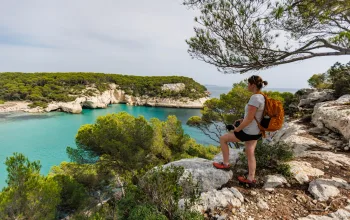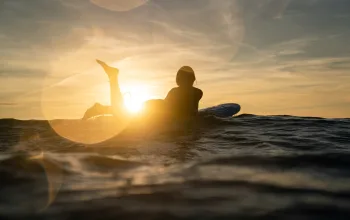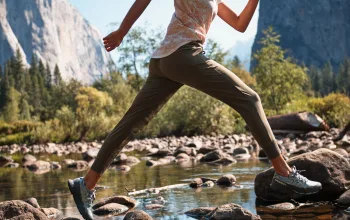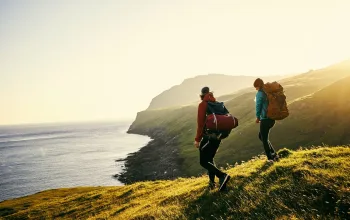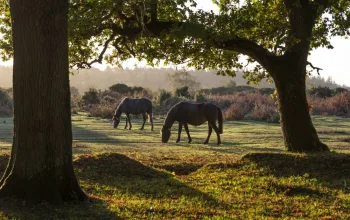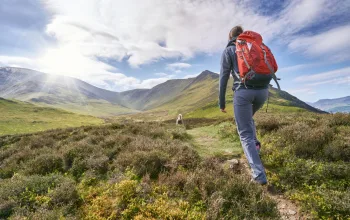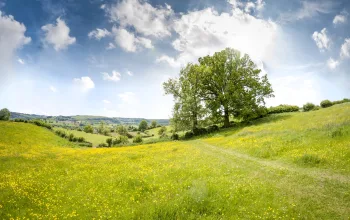Until recently, I’d never felt the urge to go rock-climbing, as I’m terrible with heights. Put me on a balcony and I’ll be gripping the railing, partly out of the conviction that I’ll throw myself off simply to get over the paralysing fear of falling.
However, there is a form of climbing which might have been designed specifically for people like me. It is via ferrata, where you follow a series of metal rungs drilled into the rock to supplement the natural foot and hand holds, but where you are also attached to a safety cable in case you fall. In fact via ferrata – Italian for the iron way – was invented in the First World War to help our Italian allies get about when they were fighting the forces of the Austro-Hungarian empire.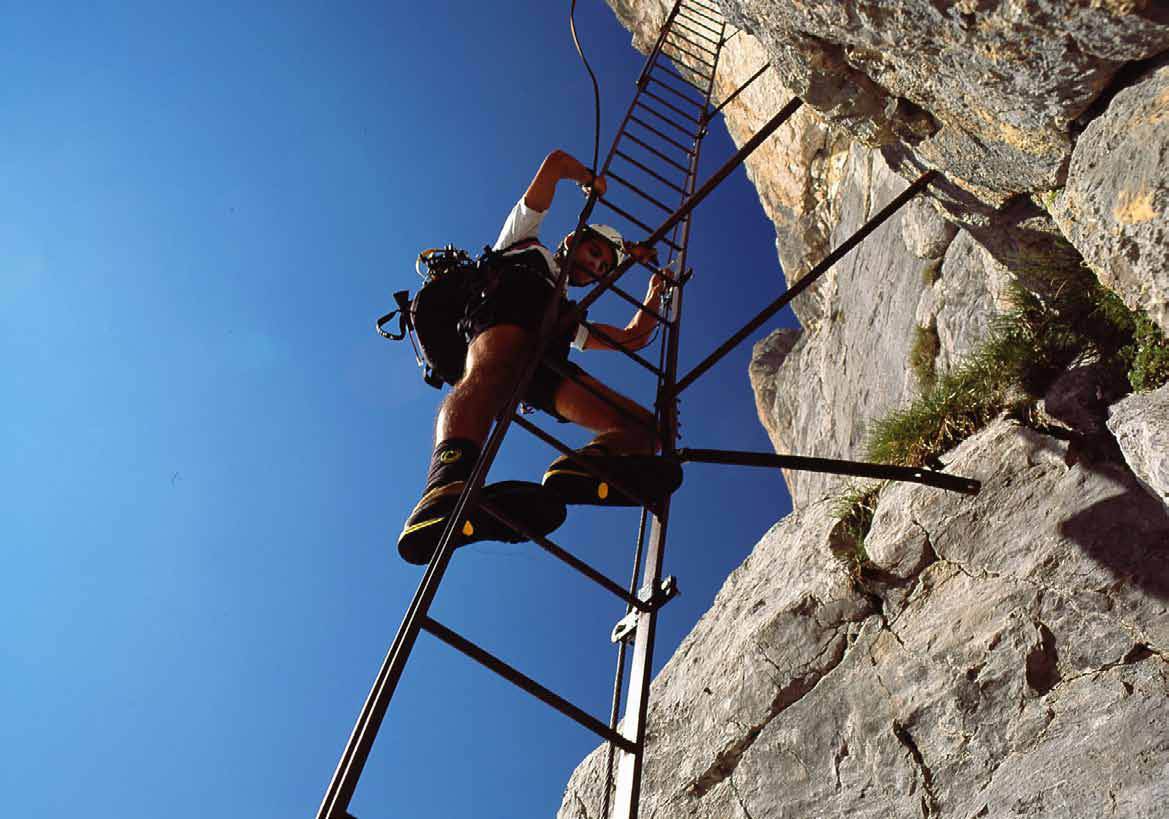
While the Western front was muddy fields, the ‘White War’ was fought in trenches high in the snow-covered Dolomites. Almost half of the via ferrata trails above Lake Garda, in north-eastern Italy, take the original soldiers’ routes, allowing you to climb over the fortifications and through the trenches and tunnels of the original battlefield on this World War One tour with a diff erence. And, on a glorious summer’s day, with my vertigo in check, I was persuaded to give it a go.
My guide was Martin from Friends of Arco, one of the mountaineering clubs that organise via ferrata excursions, and he kitted me out with a helmet and harness. The equipment had seemed surplus to requirements as we walked through the vineyards in the foothills of the Dolomites, cicadas chirping their warning and birds flapping away in alarm as we clomped by. But then we turned a corner and I saw the sheer face of the 909m Cima Capi peak dropping straight into the waters of Lake Garda below.
I could, I reflected, be back at the Grand Hotel Gardone, lying under a parasol on one of the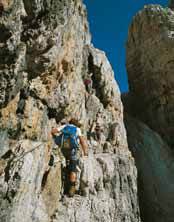 neat lines of loungers, dozing off to the regular slapping of waves on the pontoon and the clink of silverware as waiters set the tables for lunch. I was adamant that I couldn’t, wouldn’t do it.
neat lines of loungers, dozing off to the regular slapping of waves on the pontoon and the clink of silverware as waiters set the tables for lunch. I was adamant that I couldn’t, wouldn’t do it.
But somehow Martin persuaded me. After all, there is no risk of falling – or in my case throwing myself off – because you have two carabiners on your harness, so that each time you clip on to the next stretch of cable, you are held fast by the other. I just had to remember not to look down – and, seeing the height of the peak, not to look up either.
So as we climbed I studied the purple flowers clinging to the rock, the lizards basking in the sun, the ants so oblivious to the fact that they were a thousand metres above the rippling azure waters of the... don’t look down! We had already crossed the front line. The Austro-Hungarian empire covered all or part of 13 of today’s European countries at the start of the war, including swathes of modern-day Italy and the Italians wanted a piece of it, so in 1915 they attacked.
Battling my vertigo, it seemed madness that anyone would want to supplement the danger of the mountains by doing anything as silly as fighting a war. And the Italians were very silly. With such impregnable defences – we were now walking through trenches cut into solid rock – it was a suicide mission. At one point when the Italians were going over the top, the Austrians shouted at them, begging them to go back, to spare mowing them down with machine-gun fire.The compelling story of this – one of the First World War’s most protracted campaigns – has recently been told in a highly-acclaimed book – The White War, by Mark Thompson. He describes how each side even resorted to firing shells over each other’s trenches to set off avalanches above them.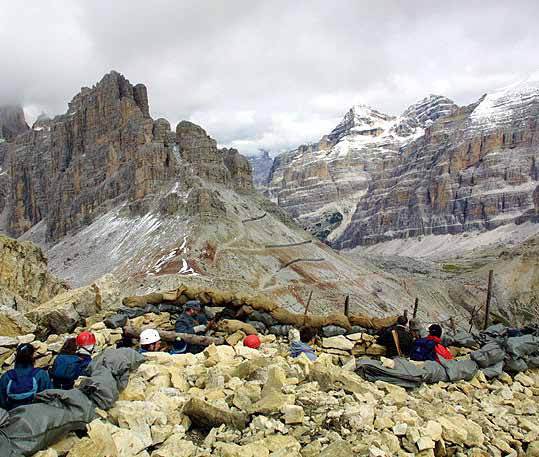
We were climbing in late June, with just a few patches of snow visible on the highest peaks. With the summer sun beating down I was grateful for the shade of the pill-box bunkers, commanding breath-taking views of the 52km-long lake. Unaware that they were ‘in range’, a fleet of ferries on the lake was taking tourists past lakeside castles, sandy beaches, and restaurants serving freshly caught fish and local wine.
For the most urbane of travellers, the south of the lake is best placed for day trips to Verona, where you can go to the opera in the Roman amphitheatre, or for a day in Venice, which is just a couple of hours away. In fact, in 1917, after two years of warfare, the Austrians came within a few miles of capturing the legendary city, before ultimately ceding power to the Allies.
By now my own battle was won, as we sat for a picnic in a trench at the top of the mountain. Like the opposing forces, my progress had been unbelievably slow. We would have to leave the tunnels on the next peak for another occasion.
So what else is there to do at Lake Garda..?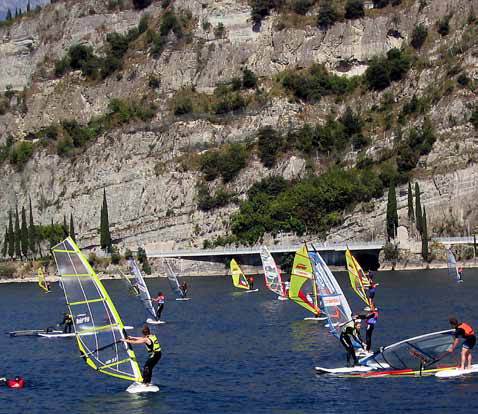
Via ferrata climbing is just one of a wealth of mountain and watersport activities on offer at Lake Garda, which is known as one of the adventure sports hot spots of Europe, and certainly its top lake for windsurfing. Less expensive and with more on offer than its celebrity-studded rival Lake Como, Lake Garda has a consistent wind which makes it popular with both windsurfers and climbers, who appreciate the dry rock.
The northern end of the lake, which is nestled in the Dolomites, is not only best for climbing, but also for mountain biking and canyoning. This involves swimming, jumping, scrambling and doing bum slides down a gorge, although you might have to muster up all your courage for the jumps into the dark, limpid pools below. First-timers should try Canyon Adventures in Torbole, which will even take confident beginners down intermediate canyons.
On the water
It is for windsurfing, catamaran sailing and kite surfing, that Lake Garda is unique, as the mountains funnel winds over the lake that run like clockwork.
The gentle, northerly Peler wind blows from 9am to around 11.30am and is good for beginners, who will find it far easier to stay upright than on the sea, with Torbole being a good place to start (try Lido Blu or Surf Segnana). More advanced surfers go for the choppier waters near Riva for the stronger, southerly Ora wind, which starts at about midday and blows through the afternoon. The most experienced surfers head down around 6.30am to Malcesine, as the strong cross winds across the lake make these ‘dawn raids’ popular.
One tip: watch out for ferries. Apart from the obvious danger, you can get fined for crossing just in front or just behind a ferry, although many freestyle surfers like to ride their wake. The warning about ferries goes for those sailing catamarans and kite surfing too. Don’t attempt kite surfing without a lesson first – friendly instructor Mika in Tropical Paradise Kitesurfing will show you the ropes as well as rent out kit in Limone, while German club Stickl Sport rents gear in Val di Sogno, just below Malcesine.
If you go cat sailing in the afternoon Ora wind, you can quickly get up on one hull and go out on the trapeze. Try the Hotel Du Lac for boat hire. It also does dinghies, but many people find cats more fun.
You can dive all around the lake, including at Sirmione on the south shore. This quaint, fortified town sits at the end of a long peninsula jutting out into the lake, with Roman ruins at the tip.
Off the water
Road bike rides vary from the easy 5km lakeside and riverside trip from Riva to Torbole via the medieval town of Arco, to a 24km route inland through the vineyards and olive groves of the colourful Loppio valley to Rovereto. Both routes are indicated on free maps available in hotels. Mountain bikers will want to head up on the tracks above Torbole for more challenging stuff, or do the famous 28km descent from Monte Tremalzo down to Tremosine, which is just behind Limone. Some companies will take people up by minibus so they can cycle down.
Even parapenting and base jumping are possible on the northern shores of Lake Garda near Arco.
Lake Garda’s ‘season’ typically runs from May to September, but some visitors prefer to avoid the hottest months of July and August. And pack a big brolly for, when the summer weather gives, the downpours are torrential.
FOOTNOTES
Getting there
British Airways (0844 493 0787, www.ba.com) offers flights to Verona, which is 15 miles from
Lake Garda, from £88 return.
easyJet (0843 104 5000, www.easyjet.com) offers flights to Verona from £55 return.
Hire a car at Verona airport. Hertz (0039 309 657302, www.hertz.co.uk) offers seven days’ hire from £151.
When to go
Most people go from May to September, but avoid the hottest months of July and August.
Where to stay
Antico Borgo, a traditional hotel in a quiet cobbled street in the centre of Riva on the north
shore. Doubles from €118/£105 half board. 0039 464 552277, www.bluhotels.it
The Grand Hotel Gardone, one of the oldest and finest hotels, extending along most of Gardone’s ‘riviera’ on the western shore. Doubles from €175.50/£155 per night b&b
0039 365 20261, www.grandhotelgardone.it
Tour Operators
Colin travelled courtesy of Crystal Summer (0871 230 8180, www.crystalsummer.co.uk)
which offers a seven-night half board package at the four-star Grand Hotel Gardone from £695 per person, including flights and transfers.
Thomson Lakes (0871 230 8181, www.thomsonlakes.co.uk) offers seven nights B&B at the three-star Hotel Astoria in Garda from £459 per person, including flights and transfers.
Useful contacts
Brescia tourist board 0039 030 374 9438, www.bresciatourism.it
Trentino tourist board 0039 461 219500, www.trentino.to
Veneto tourist board 0039 457 210078, www.veneto.to
Surf Centre Lido Blu www.surflb.com
Surf Segnana www.surfsegnana.it
Tropical Paradise Kitesurfing www.tropical-paradise-kitesurfing.com
Stickl Sport Camp www.stickl.com
Canyon Adventures www.canyonadv.com
Top tips
All of the provinces’ websites give details of accommodation and camping sites.
Must do
Via ferrata with Friends of Arco 39 0464 532828, www.friendsofarco.it


